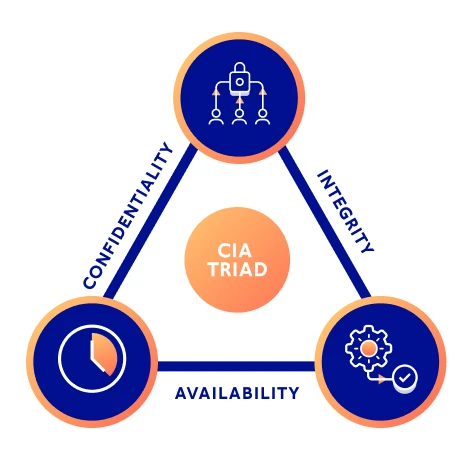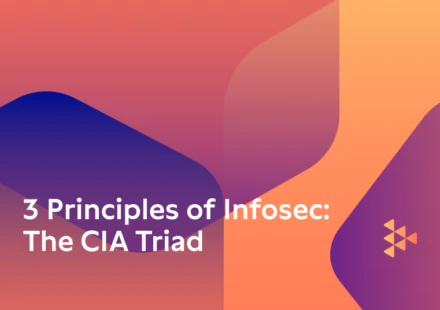Not to be confused with a well-known intelligence agency of the same acronym, the CIA Triad stands for Confidentiality, Integrity, and Availability. It is a model within Information Security that is designed to guide policies within an organization and is used to introduce controls and remediation strategies along with the primary security infrastructure of the organization.
These principles are the most integral elements of information security and should function as the primary goals of any organization’s security framework. Multiple popular security frameworks (like SOC 2, ISO 27001, and PCI DSS) are built around these three principles. Should each of these principles be adapted appropriately, you can trust that data security best practices are operating at full capacity.

Confidentiality of Data
This principle of the CIA Triad deals with keeping information private and secure as well as protecting data from unauthorized disclosure or misrepresentation by third parties. That means ensuring that only those who are authorized obtain access to necessary data, while those who are unauthorized are met with preventive measures to keep them from accessing the data.
Attacks that threaten confidentiality are any attack that aims to intercept access to the data. Keyloggers and port scanners are examples of attack mechanisms that aim to threaten confidentiality.
A major part of protecting the confidentiality of data is controlling who has access to it. One way to keep data confidential is with the use of encryption in data transfers. This ensures that only the authorized parties have access to the data being transmitted.
You can also manage data access with password policies that ensure all data is password-protected. Also, be sure to enable multi-factor authentication for access.
One final way to keep data confidential is by employing physical access controls by keeping drives and physical copies of data locked in cabinets or storerooms only accessible to authorized individuals.
Integrity of Data
This principle of the CIA Triad considers the completeness, consistency, and accuracy of the data over its lifecycle. This means ensuring that the data is not altered in any way whether in transit or housed in data storage. Mitigation steps must be taken to ensure that integrity is maintained and that the data isn’t tampered with.
When considering data integrity, it is important to consider, is the data exactly as it was when first received or created? Can we ensure its validity throughout the lifecycle of its use?
Malware and cyberattacks are the biggest threats to data integrity. Integrity also means ensuring that the data does not get corrupted in any way, either by attack or human error, as damage in and of itself, is a form of change to the data. Any damage may impact the accuracy of any data reporting necessary for your business operations.
One way to ensure data integrity is to avoid duplicate data. A data inventory can help you keep track of the data that you house and its flow throughout your organization to ensure that you don’t have duplicate data and that the data you have is complete and accurate. Duplicate data or backups could be altered in one location and remain the same in another, which begs the question of accuracy for both.
This goes for physical copies as well as digital duplicates. Even if you are removing duplicate sources of data, you still need to ensure that you have accurate backups available. Backups might also need to be updated in the case of data subjects making changes to their information under the regulation.
Availability of Data
This principle of the CIA Triad pertains to the assurance that all data and applicable systems will remain available for uninterrupted access to appropriate and authorized personnel. This means ensuring that information and the services that utilize it are available to necessary users when they need it for regular business operations.
A Denial-of-Service (DoS) attack targets data availability, aiming to shut down a machine or network and making it inaccessible to authorized users. Often availability can also be impacted by more than just cybersecurity incidents. A reliable data system can be impacted by a network failure, human error, or a hardware matter all of which impact the ability of an organization to deliver necessary services. A network crash can cause downtime which then decreases the availability of that needed information system for the user. Ensuring availability, in response, is meant to address these concerns by mitigating the risk and impact of any potential downtime.
One important way to do this is by establishing a disaster recovery plan for any perceived threats to data systems before they happen. A disaster recovery plan can ensure that there is minimal downtime in the event of a data system disruption and can also act as a temporary backup plan until systems are restored when disaster strikes.
InfoSec companies across the board also agree that data redundancy, or keeping multiple backups of systems and information, is another excellent way and best practice towards availability.
Getting Secure With Carbide
Companies that utilize the principles of the CIA Triad put themselves in a position to have a solid and foundational security program. Our platform helps create a robust information security program with custom, auto-generated policies and a team of experts ready to help you get compliant with frameworks like GDPR, HIPAA, SOC 2, and more. Book a demo with us today to learn more about how we can help you establish yourself as a trusted business that cares about security.

